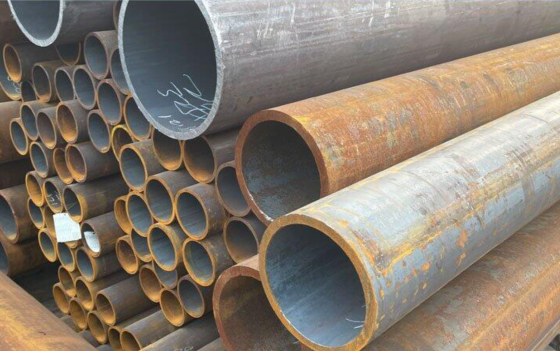
What is carbon steel pipe surface roughness?
The surface roughness of carbon steel pipe refers to the small spacing and the unevenness of small peaks and valleys on the machined surface. The distance (wave pitch) between the two wave crests or two wave troughs is very small (below 1mm), which belongs to the micro-geometric error. The smaller the surface roughness of the carbon steel pipe, the smoother the surface.

Surface roughness is closely related to the matching properties, wear resistance, fatigue strength, contact stiffness, vibration and noise of mechanical parts, and has an important impact on the service life and reliability of mechanical products. Ra is generally used for marking.
Common range of surface roughness (Ra) of carbon steel pipe:
Hot-rolled seamless pipe:
Surface roughness: 6.3~12.5 μm
Surface features: obvious oxide scale, need pickling or sandblasting
Cold-rolled/cold-drawn pipe:
Surface roughness: 0.8~3.2 μm
Surface features: relatively smooth, may have slight rolling lines
Precision cold-drawn pipe:
Surface roughness: 0.4~1.6 μm
Surface features: close to mirror surface, suitable for high-precision hydraulic system
Welded steel pipe:
Surface roughness: 3.2~6.3 μm
Surface features: slightly rough in the weld area, need grinding
Key factors affecting roughness:
Production process:
Hot-rolled pipe has high roughness due to high-temperature oxide scale, and cold-rolled/cold-drawn pipe obtains a smoother surface through die extrusion.
Die/roller status:
Worn rolls or drawing dies will increase surface ripples (such as "bamboo knots" on cold-drawn pipes).
Subsequent treatment:
Sandblasting/polishing: Ra can be reduced to below 1.6 μm (such as decorative stainless steel composite tubes).
Pickling/phosphating: remove oxide scale and form uniform roughness (Ra 2.5~5 μm).
Measures to improve roughness:
Machining:
Use turning and grinding to control Ra at 0.4~3.2 μm (such as hydraulic cylinder barrel).
Chemical treatment:
Passivation after pickling to form a uniform surface (Ra 2~5 μm).
Coating technology:
Before spraying epoxy resin, sandblasting is required to enhance bonding strength.
The influence of surface roughness on carbon steel parts is mainly manifested in the following aspects:
7. Affect the measurement accuracy. The surface roughness of the measured surface of the part and the measuring surface of the measuring tool will directly affect the accuracy of the measurement, especially in the precise measurement.
In addition, surface roughness will have varying degrees of influence on the coating, thermal conductivity and contact resistance of parts, reflectivity and radiation properties, resistance to liquid and gas flow, and current flow on the conductor surface.
Selection suggestions:
High precision requirements (such as medical equipment): select cold-drawn tubes (Ra≤1.6 μm) + electrolytic polishing.
Anti-corrosion coating: select hot-rolled tubes after sandblasting (Ra 4~6 μm).
Economical structural parts: directly use hot-rolled tubes (Ra 6.3~12.5 μm).
Conclusion:
The surface roughness of carbon steel pipe is an important parameter for engineering selection, and it needs to be selected comprehensively based on functional requirements (seal/fluid/coating) and cost. Generally, cold-rolled pipes are better than hot-rolled pipes, but special scenarios (such as coating adhesion) may require a certain degree of roughness.
